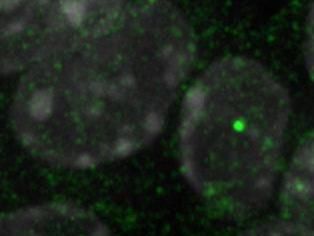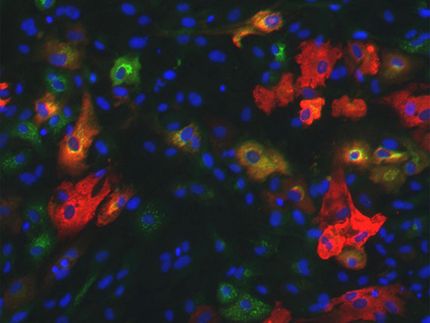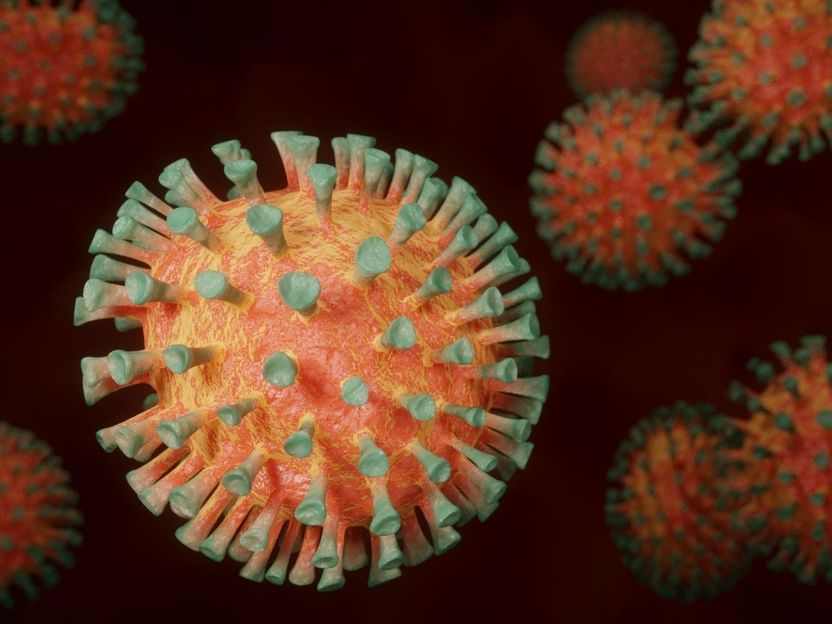Genetic cross-talk key to cell balance
Competing regulatory genes "talk" to each other to maintain balance of cell state, according to new research from the Stowers Institute for Medical Research.

The brightest green spot is where Nanog mRNA is being transcribed within a cell nucleus, while the dimmer green spots indicate stable Nanog transcirpts elswehere in the cell.
Bony De Kumar, Ph.D., and Robb Krumlauf, Ph.D.
In a study Stowers scientists Bony De Kumar, Ph.D., and Robb Krumlauf, Ph.D., provide evidence of direct cross-regulatory feedback, or cross-talk, between Nanog and Hox genes.
Nanog and Hox genes regulate cell pluripotency and differentiation, respectively. When cells are pluripotent, they have the capacity to self-renew and the potential to change into any of a number of cell types. And when cells differentiate, they become a more specialized cell type, like heart, brain, or skin cells.
In adult organisms, striking a balance between these two states is important to keep many tissues in equilibrium. The blood supply, for example, has cells that are differentiating, dying, or being repaired, and a reserve population of blood-producing adult stem cells is needed to help replace them.
The Stowers study suggests that balance between pluripotency and differentiation hinges in part on regulatory communication involving inhibition between Nanog and Hox genes. Krumlauf compares this cross-talk to parents giving their children instructions.
"Parents may say, 'You need to get good grades; you need to learn this,' for positive guidance but they are likely to reinforce the importance of that advice and minimize negative outcomes by saying, 'You don't want to do this,'" says Krumlauf, an investigator and scientific director at the Stowers Institute and senior author of the study.
Both positive and negative instructions are important. Nanog and Hox genes each have their own distinct jobs and by inhibiting each other they work together to direct the proper balance of cell states by helping the cell avoid wrong turns and stay on course.
"Differentiation and pluripotency are well-studied processes," says first author De Kumar. "This paper actually links the processes together. Before, we did not know that these pathways were talking to each other. It was pretty surprising for us."
The researchers made the discovery while studying Hox genes in the early stages of mouse embryonic stem cell differentiation. These "architect genes" control the layout of a developing embryo and play a key role in the establishment of the basic body plan and craniofacial development.
At two hours and 12 hours of retinoic acid treatment, the researchers found that both Hox and Nanog genes bound to many of the same target sites in the cell, indicative of the regulatory cross-talk between the pluripotency and differentiation pathways. The researchers also observed that depending on the context, Hox and Nanog repress each other. The findings paint a picture of cell states that is more plastic than in a fixed program.
"Over the past 10 to 20 years, biologists have shown that cells are actively assessing their environment, and that they have many fates they can choose. The regulatory loops we've found show how the dynamic nature of cells is being maintained," says Krumlauf, who was recently inducted into the National Academy of Sciences for his seminal work on Hox genes.
The work provides important insight into the basic processes of tissue formation, and holds relevance for the field of regenerative medicine and the development of therapeutic approaches for certain cancers.
























































